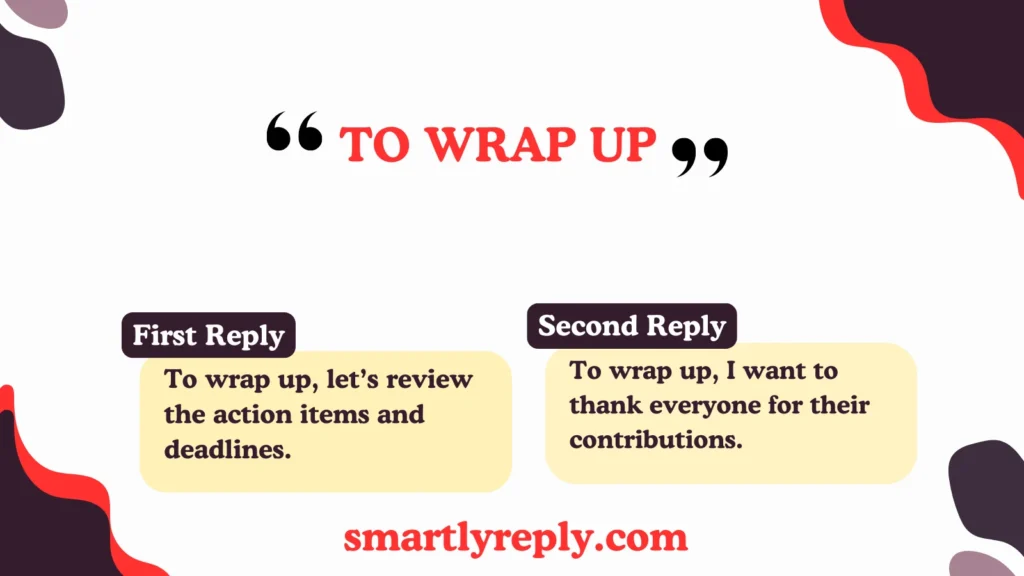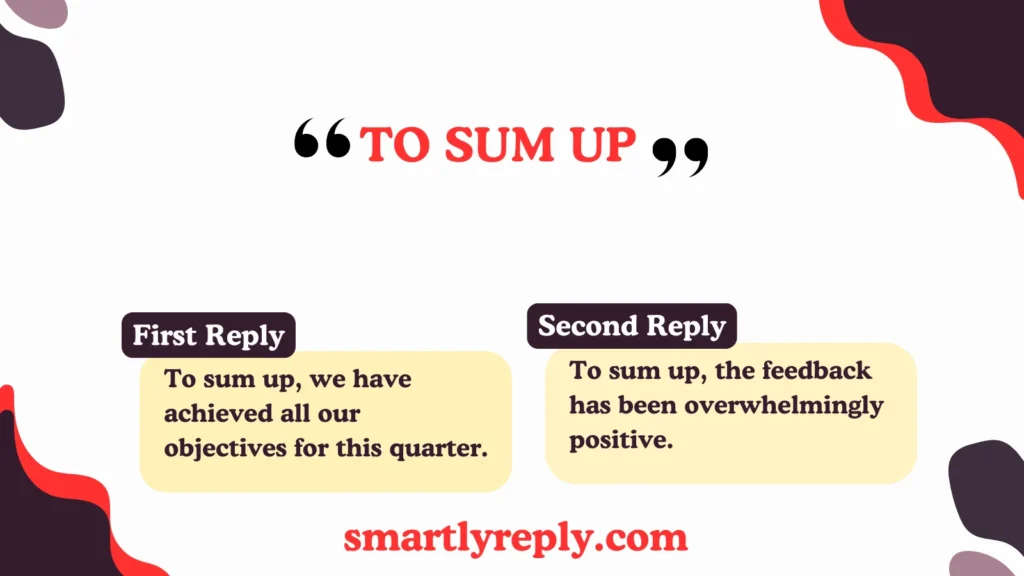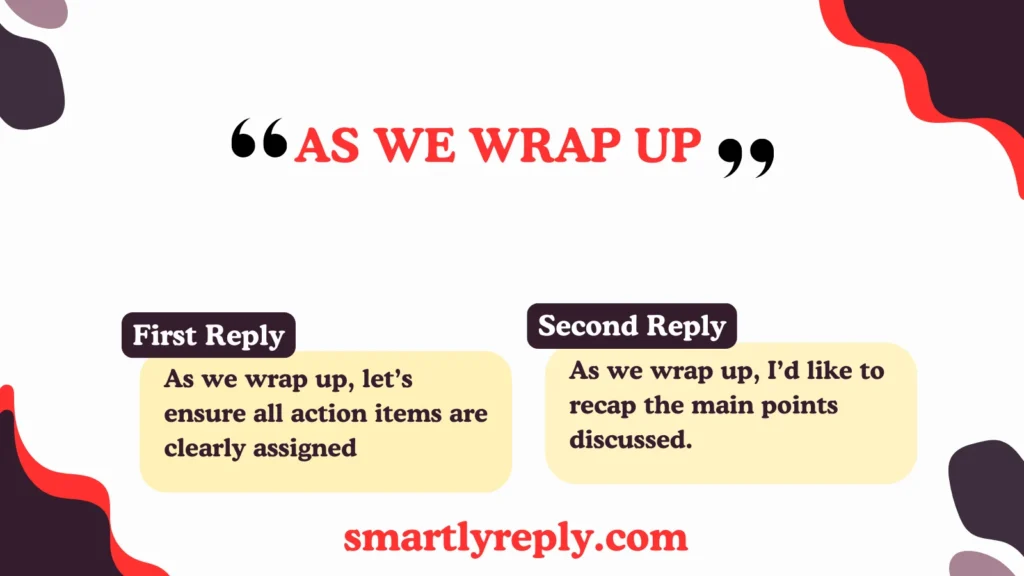Last Updated on October 28, 2024 by
Summarizing or closing out a discussion or document can be done in various ways. Here are 20 alternative phrases to “In conclusion,” complete with definitions, scenarios, and examples to help you wrap up your thoughts effectively.
1. “To Summarize”
Definition: Offering a brief overview of the main points.
Scenario: At the end of a presentation.
- Example 1: “To summarize, our research indicates significant improvements in efficiency.”
- Example 2: “To summarize, we’ve covered the key strategies for increasing productivity.”
2. “To Wrap Up”

Definition: Bringing a discussion or document to a close.
Scenario: During a meeting wrap-up.
- Example 1: “To wrap up, let’s review the action items and deadlines.”
- Example 2: “To wrap up, I want to thank everyone for their contributions.”
3. “In Closing”
Definition: Signaling the end of a discussion or document.
Scenario: At the end of a formal speech.
- Example 1: “In closing, I’d like to thank everyone for their attention and participation.”
- Example 2: “In closing, we look forward to the next steps in our collaboration.”
4. “To Conclude”
Definition: Indicating the final part of a discussion or argument.
Scenario: After presenting an argument or report.
- Example 1: “To conclude, our analysis supports the proposed changes.”
- Example 2: “To conclude, I believe we have addressed all the key issues.”
5. “In Summary”
Definition: Providing a concise overview of the main points.
Scenario: After detailing a set of findings.
- Example 1: “In summary, the findings highlight several areas for improvement.”
- Example 2: “In summary, the project was a success due to effective teamwork.”
6. “Overall”
Definition: Offering a general assessment of the entire discussion.
Scenario: Concluding a report or essay.
- Example 1: “Overall, the results suggest a positive outcome from the new strategy.”
- Example 2: “Overall, we can see that the implementation was effective.”
7. “To Round Off”
Definition: Bringing a topic or discussion to a final point.
Scenario: In a business meeting summary.
- Example 1: “To round off, let’s finalize the next steps and responsibilities.”
- Example 2: “To round off, we’ll need to ensure all team members are informed.”
8. “In a Nutshell”
Definition: Providing a brief and clear summary.
Scenario: Concluding a detailed explanation.
- Example 1: “In a nutshell, we’ve successfully implemented the new system.”
- Example 2: “In a nutshell, the project exceeded expectations.”
9. “To Sum Up”

Definition: Offering a final summary of the discussion.
Scenario: After a detailed discussion.
- Example 1: “To sum up, we have achieved all our objectives for this quarter.”
- Example 2: “To sum up, the feedback has been overwhelmingly positive.”
10. “In Final Thoughts”
Definition: Presenting concluding remarks or reflections.
Scenario: At the end of an essay or report.
- Example 1: “In final thoughts, it is clear that our approach was effective.”
- Example 2: “In final thoughts, the evidence supports the proposed hypothesis.”
Looking for the perfect response? Visit our Smartly Reply homepage for expert answers to every situation!
Read more and level up your replies Smartly Reply
11. “To Finish”
Definition: Indicating the end of a discussion or presentation.
Scenario: Wrapping up a presentation.
- Example 1: “To finish, I’d like to address any remaining questions.”
- Example 2: “To finish, we will summarize the key points from today’s discussion.”
12. “As a Final Point”
Definition: Introducing the last key idea or summary.
Scenario: Concluding a debate or argument.
- Example 1: “As a final point, I’d like to reiterate the main advantages of our proposal.”
- Example 2: “As a final point, let’s highlight the impact of the new policy.”
13. “In Conclusion”
Definition: Summarizing or closing a discussion or document.
Scenario: Summarizing a research paper.
- Example 1: “In conclusion, our research provides new insights into the topic.”
- Example 2: “In conclusion, the evidence supports our initial hypothesis.”
14. “Finally”
Definition: Signaling the last point or summary.
Scenario: At the end of a presentation.
- Example 1: “Finally, let’s review the main takeaways from today’s meeting.”
- Example 2: “Finally, I want to thank everyone for their contributions.”
15. “To Bring It All Together”
Definition: Summarizing and integrating key points.
Scenario: At the end of a workshop or seminar.
- Example 1: “To bring it all together, we’ve discussed key strategies for improving performance.”
- Example 2: “To bring it all together, let’s review the action items and next steps.”
16. “As We Wrap Up”

Definition: Indicating the process of concluding a discussion or meeting.
Scenario: At the end of a team meeting.
- Example 1: “As we wrap up, let’s ensure all action items are clearly assigned.”
- Example 2: “As we wrap up, I’d like to recap the main points discussed.”
17. “In the End”
Definition: Offering a final summary or reflection.
Scenario: Concluding a project evaluation.
- Example 1: “In the end, the project was successful due to effective teamwork and planning.”
- Example 2: “In the end, the results validate our strategy and approach.”
18. “In Review”
Definition: Summarizing and reviewing key points.
Scenario: At the conclusion of a performance review.
- Example 1: “In review, the project met all its objectives and deadlines.”
- Example 2: “In review, the feedback highlights several areas for growth.”
19. “In Closing Remarks”
Definition: Offering final comments or observations.
Scenario: At the end of a formal event or speech.
- Example 1: “In closing remarks, I want to thank everyone for their participation and input.”
- Example 2: “In closing remarks, we recognize the achievements of our team.”
20. “To Draw to a Close”
Definition: Bringing a discussion or document to an end.
Scenario: At the end of a conference.
- Example 1: “To draw to a close, I’d like to thank all our speakers and attendees.”
- Example 2: “To draw to a close, let’s summarize the key outcomes and next steps.”
Conclusion
In the end, having a variety of expressions to replace the classic “in conclusion” allows for a more engaging and tailored finish to any message. Whether you’re aiming for a formal tone, looking to add flair, or simply hoping to keep your audience’s attention, a thoughtful choice of words can make a lasting impact. By selecting the right phrase, you not only sum up your thoughts but also leave readers with a memorable final note. So, try swapping in one of these alternatives next time to keep your closing fresh and impactful!


